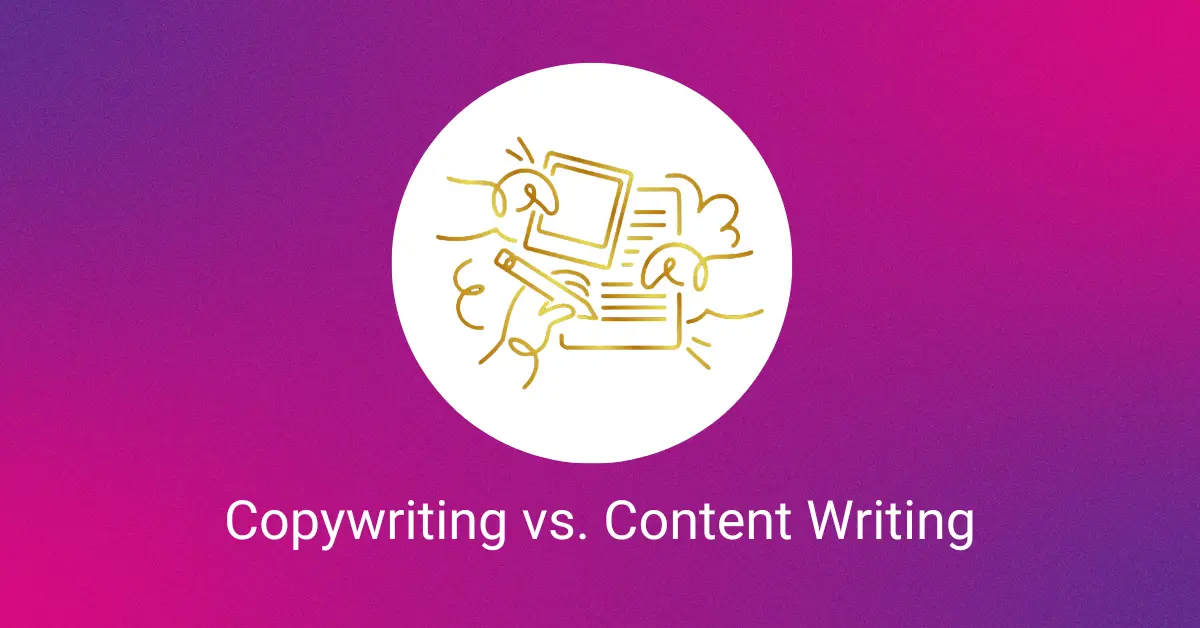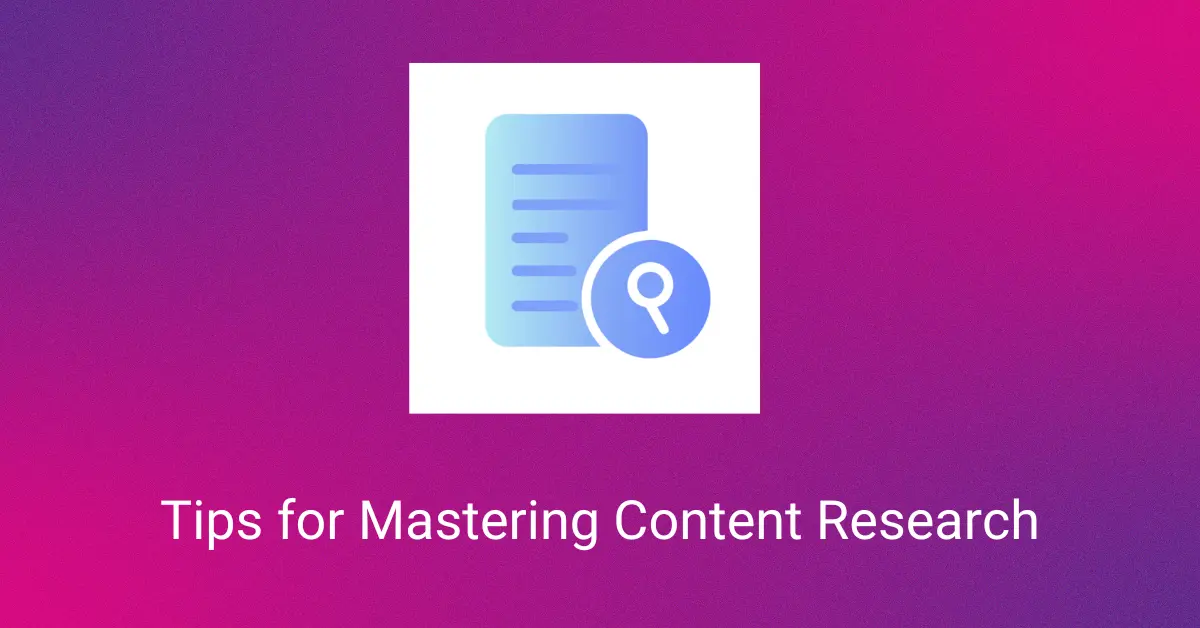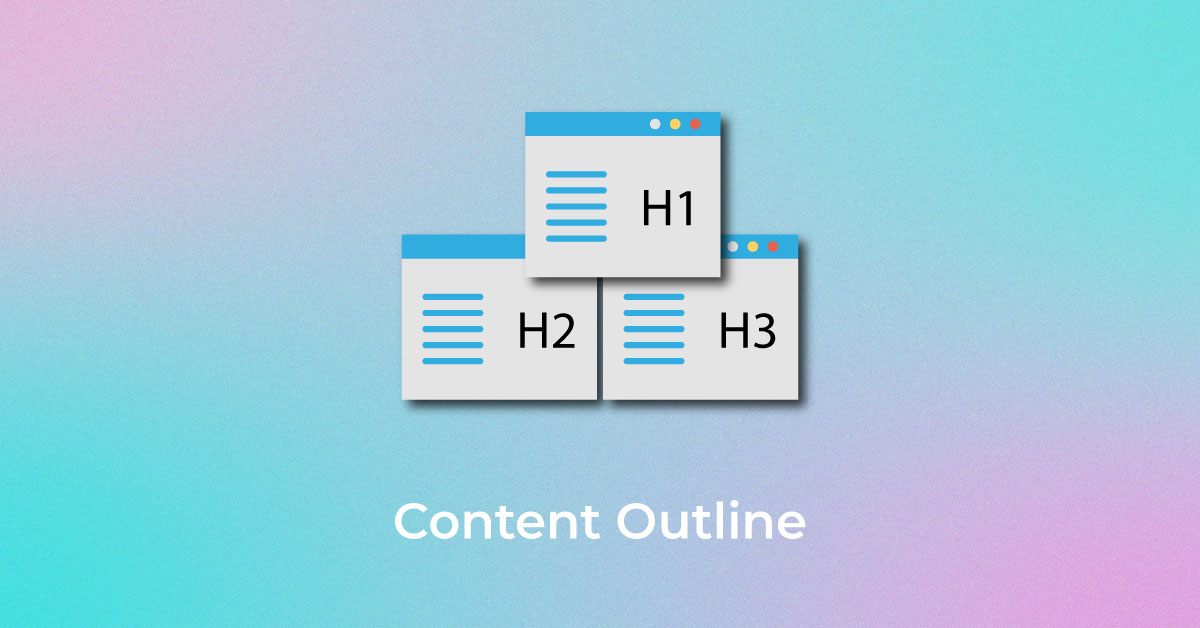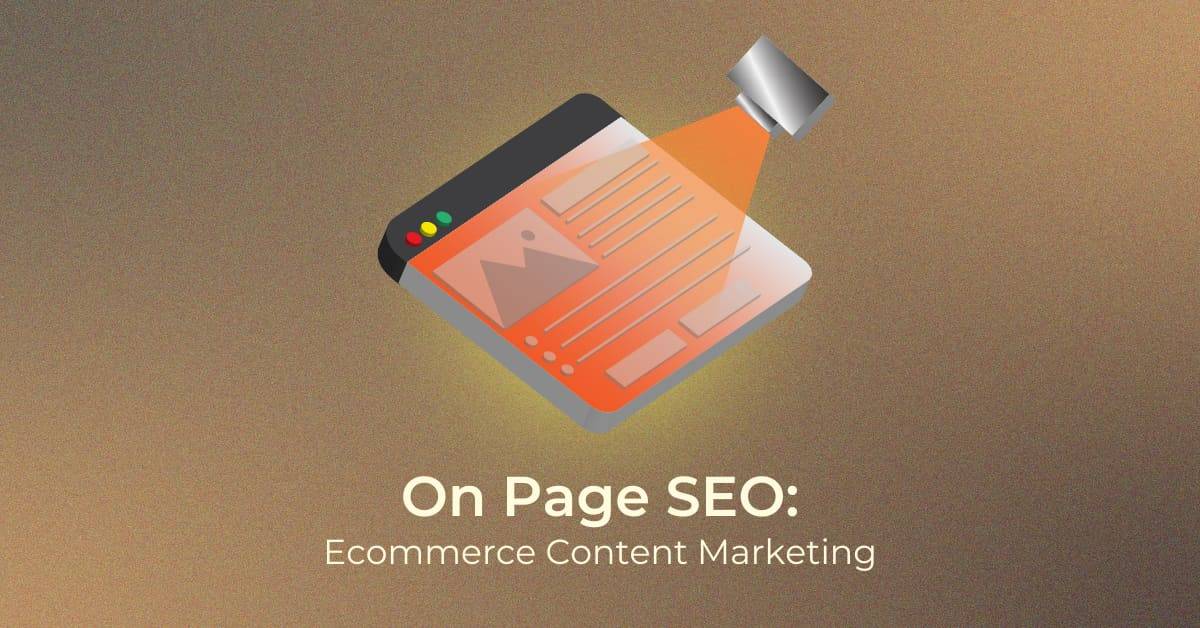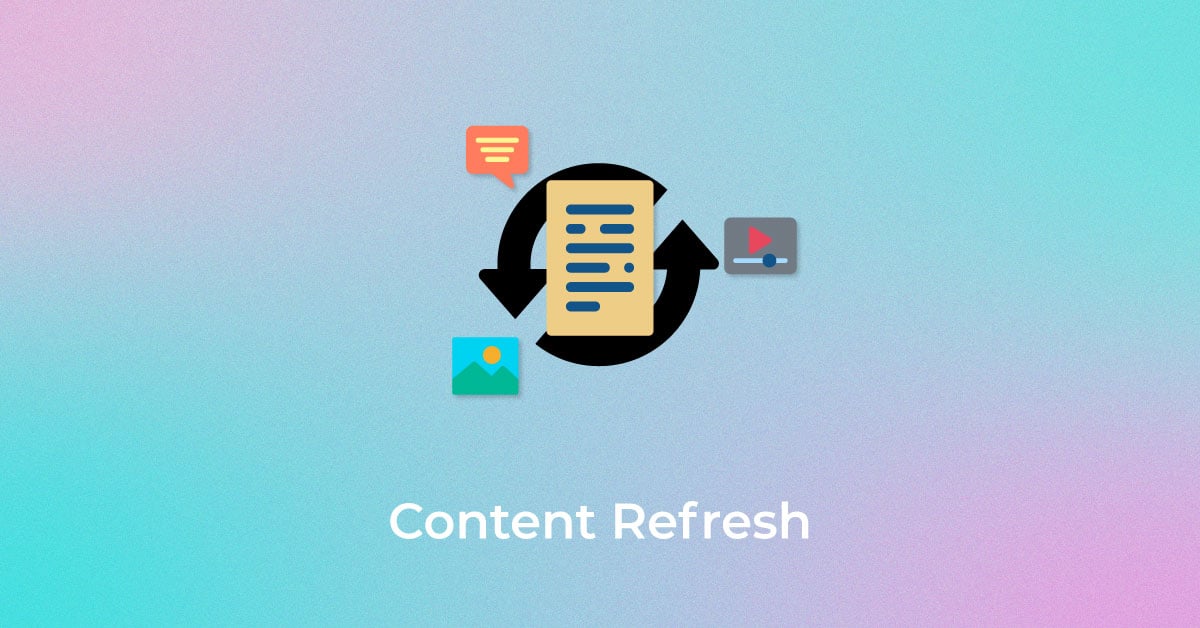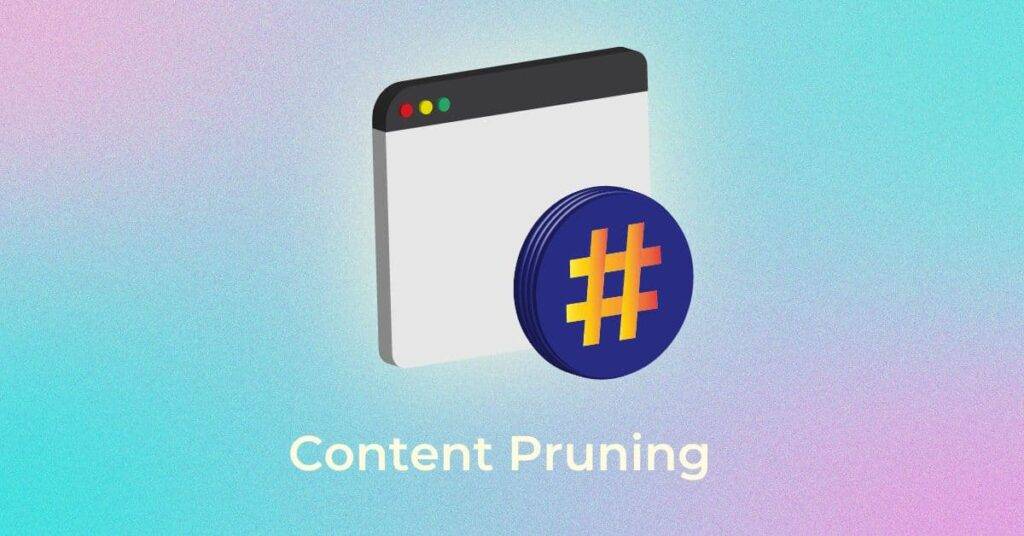While the content creation aspect of search engine optimization (SEO) is crucial to a website’s ranking and performance, it is equally important to review the existing content on the website. The content on a website should be accurate, informative, and relevant. Removing outdated content from your website can actually improve its ranking.
Over the past few years, the idea of “less is more” has been increasingly applied to the existing content on websites. This became more relevant since Google’s Panda 4.0 update, thus making content pruning an important exercise. What is content pruning and how can it help? Let’s find out.
What Is Content Pruning?
Content pruning is the process of removing or updating the existing content on a website, which might no longer be useful or relevant. This type of content often brings down the SEO performance of a website, and is considered dead weight by search engine algorithms. Examples of content that is usually pruned include duplicate and outdated content as well as content that generates neither traffic nor user engagement.
Why Is Periodic Pruning Necessary?
Content pruning, when done regularly:
- Optimizes pages that do not generate any engagement
- Offers visitors a better user experience by removing the dead weight from the website
- Identifies duplicate content that can potentially attract penalties
- Improves the authority of the overall content on your website for search engine algorithms
Unlock higher rankings, quality traffic, and increased conversions through tailored award-winning SEO strategies.
Elevate your web presence by Infidigit’s SEO solutions.
Unlock higher rankings, quality traffic, and increased conversions through tailored award-winning SEO strategies.
Is content pruning only useful for large websites?
While content pruning is very important for large websites with thousands of pages, it is also recommended for smaller websites. The primary reason is that you would want your website to offer the most relevant and useful content to the users and improve your content authority for search engine bots.
Benefits of Content Pruning
Content pruning has several benefits. Done right, it produces tangible results. Among these benefits are:
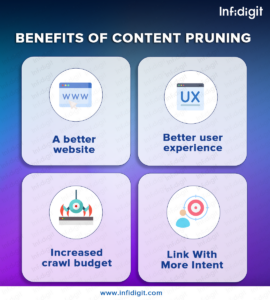
1. A better website
Content pruning can help improve the overall quality of your website. Removing content that offers little to no value to your users indicates to search engine algorithms that you care about the quality of your website. Moreover, removing content that generates little to no engagement can help trim your website by shedding off unnecessary content.
2. Better user experience
No visitor to a website will stay on if the content or the experience is short of satisfactory. Likewise, anyone who owns a website would genuinely want visitors to browse their website and encounter relevant and useful information. Content pruning helps cut out irrelevant pages with unsatisfactory content, or pages that users show no interest in. This exercise can help in improving the overall user experience of your website.
3. Increased crawl budget
Any website would want search engine bots to crawl through the website pages that really matter; pages that have the potential to bring in organic traffic. While this is especially beneficial for large websites with over 10,000 pages, smaller websites can also smartly distribute their crawl budget using content pruning.
4. Link With More Intent
Content pruning can help websites better distribute their link authority across their content. By pruning content or pages on your website that do not add any value or engagement, you are ensuring that the link authority is flowing through pages that have the potential to generate engagement. This can mean better intent for your links.
How to perform Content Pruning?
Here are the steps in the content pruning process:
1. Specify what you’re going to audit
There can be many pages on your website with evergreen content. It can be updated with new and relevant information, such as examples, newer statistics, and so on. However, other old posts on your website might be affecting your website’s SEO performance by clogging it with low-quality content. Determining the pages that are indexed on your website and the ones that require evaluation for pruning is the first step of content pruning.
2. Identify underperforming pages
Using Google Webmaster Tools, you can perform a thorough website analysis and get relevant data on the number of impressions your pages are getting. This includes click through rate (CTR), average position, clicks, and more. It can help you find low-ranking pages that are not performing well. These pages can be updated, or pruned, to perform better.
3. Get traffic and backlink information
Getting information on your Web pages about the traffic they are generating can be immensely useful when carrying out content pruning. Pages without backlinks, or which generate minimal to no traffic can be added to the list of pages to be pruned.
4. Choose whether to edit posts or delete them
After identifying the pages that are not generating any engagement or adding value to your website, you can do a quick analysis of whether these pages need to be pruned or updated. Sometimes, editing content on the page and optimizing it for better SEO performance can do the trick too. If the content cannot be edited in any meaningful manner, it can be pruned from the website.
Best Tips & Tricks for Content Pruning
A website’s content is crucial to its rankings and overall visibility. To rank higher and attract organic traffic, it is necessary to keep the information on the website up-to-date and accurate. This is where content pruning comes into the picture.
Content pruning allows you to identify low-quality or outdated content and prune it from the website and improve your SEO (Search Engine Optimization) rankings and user experience.
This is how conducting content pruning SEO at regular intervals can improve your website’s visibility:
- Content pruning allows you to optimize web pages that are no longer engaging or useful for the audience
- The content pruning process allows you to identify duplicate content on your website that may affect your rankings and lead to penalties
- Pruning your website content cuts the dead weight which is pulling your site down in SERPs (Search Engine Results Pages) and offers a better user experience
Here is the list of best tips and tricks for content pruning:
1. Success requires coordination
A successful content-pruning SEO exercise requires coordinated efforts at every stage. Your content marketing team must work together to prune obsolete or low-quality content. Remember that quality matters over quantity.
Hence it becomes imperatibe to focus on the quality of content to offer a great user experience.
The team must trim all the irrelevant pages and low-quality content to ensure users find the most accurate and updated content on your website. Further, content pruning will be a futile practice if your new content is unsatisfactory or inferior.
So, it is critical to publish high-quality content optimised for users and search engines. When it comes to evergreen pages that still attract traffic, you can update them with fresh information such as examples, statistics, images, and more.
2. Early participation of all parties
Content pruning requires the early participation of all the parties. The structure of the content marketing teams may vary with organizations. But you may need to take the help of other teams like developers or technical SEO for overall content optimization of your website. Ensure you include everyone early in the content pruning process and define the goals you are trying to accomplish through the exercise. As search engines constantly search for new content, all parties need to stay alert to optimize the site content that aligns with the quality standards of search engines.
3. The first choice isn’t content pruning
No doubt, content pruning is an effective way to improve site visibility. However, it must not always be your first choice. Pruning your site content is unnecessary if you are new in the industry or have just launched a website with few pages.
You must focus on producing quality content that meets the needs of your target audience. Once you have enough content on your website and have built traffic, you must analyze how to optimize the content to retain your site visitors. You should also acquire high-value backlinks from authoritative websites and promote your content on the right platforms to attract an audience.
Implement Content Pruning Seamlessly With Infidigit
Google is adamant about the quality and accuracy of the content and the engagement it generates. Having the help of a professional SEO service provider with vast experience in the domain like Infidigit can help you identify the pages on your website that can be pruned. Contact us today to learn more.
Popular Searches
How useful was this post?
0 / 5. 0










